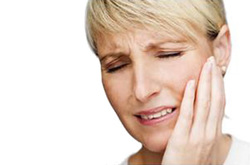
The Temporomandibular Joint (TMJ) is often considered one of the most complex joints in the body. It is just in front of the ears, where the lower jaw hinges. To find the TMJ joint place your fingers just in front of your ears and open your mouth. The temporomandibular joint is quite unique from other joints in your body; the TMJ joint is a complex joint that works like a hinge yet it also slides forward and back.
If this joint and its accompanying soft-tissues are restricted or unbalanced, it can cause conditions such as headaches, earaches, facial pain, vision problems, eye pain, teeth problems, balance issues, tinnitus, throat and neck pain, dizziness, and a host of other symptoms. Most of the complaints that arise from TMD (Temporomandibular Joint Disorder) are located in the muscles that surround the joint. In less severe cases of TMD the only symptom may be a clicking or popping sound. These are usually caused by the muscles tightening up to protect the overused joint. Habits such as chewing gum, clenching or grinding teeth, or biting nails can lead to more problems. This condition usually starts out as a minor annoyance can become a major dysfunction.
Over a period of time, repetitive motion creates tension, friction, and micro tears in the muscle tissue that surrounds the jaw. These micro tears create inflammation and the formation of scar tissue (adhesions). This weakens the surrounding musculature, creates muscle imbalances, and effects neuromuscular and vascular function.
Do you have TMJ?
TMJ symptoms vary, but you may want to be examined by a professional if you show many of the following symptoms:
· Clicking and popping of the jaw when you open your mouth
· Pain in the TMJ area when opening and closing the mouth
· Pain when yawning or chewing
· Headaches or earaches
· Pain in the jaw upon waking up
· Jaws that get stuck or locked
What you can do to reduce TMJ symptoms:
There are several relaxation exercises that you can do to reduce TMJ disorder symptoms and with treatment to prevent the recurrence of TMJ pain. Try some of these tips:
Do:
· Keep your lips together, but your teeth apart when not talking or eating.
· When eating try not to open wider than two fingers’ width.
· Massage the area gently, first with your mouth closed, then with your mouth open.
· Perform relaxation exercises for the jaw
Don’t:
· Don’t clench your jaws. Try to keep them relaxed throughout the day.
· Try not to chew gum.
· Avoid sleeping on your stomach since this can misalign your jaw.

 RSS Feed
RSS Feed